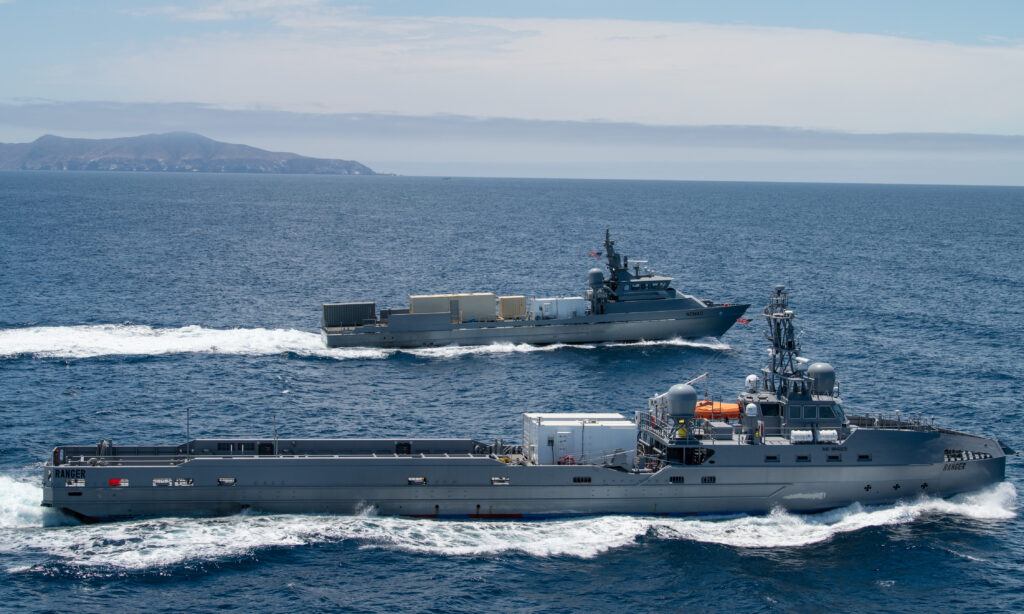
The unmanned surface vessels Nomad and Ranger conduct underway
operations off the coast of California in 2021. (Source: U.S. Navy.)
WASHINGTON: Fresh from a second autonomous unmanned surface vessel successfully transiting more than 4,000 miles, officials from the Navy and the Pentagon’s Strategic Capabilities Office say their teams will stay joined at the hip for further fleet demonstrations and operational assessments as they prove out new technologies vital to the Navy’s envisioned distributed fleet.
“The intent is to utilize this time period to do fleet demonstration exercises and operational vignettes to continue to demonstrate in an operational context the utility of these vessels to augment manned combatant capabilities,” Luis Molina, SCO’s deputy director told reporters during a telephone roundtable on Tuesday, referring to his agency’s Ghost Fleet Overlord program.
Overlord is the Pentagon’s premiere — and somewhat secretive — USV development program that the Office of the Secretary of Defense has been using for several years now to inform the technology and capabilities that will one day be onboard most unmanned maritime vessels populating the Navy fleet.
In October 2020, a USV dubbed Ranger transited 4,700 miles from the Gulf Coast, passing through the Panama Canal and to its destination on the West Coast. A second USV, dubbed Nomad, completed a similar journey last month.
Capt. Pete Small, program manager for the Navy’s unmanned maritime systems program office, told reporters during the same roundtable that Nomad operated for nearly the entire trip in an autonomous fashion, with the exception of its transit of the Panama Canal.
Small’s team is also spearheading key projects for the Navy’s future unmanned fleet. One example is the Common Control System, a command and control solution designed by Raytheon that the Navy hopes can be used across the unmanned fleet, from the carrier-bound MQ-25A Stingray aerial tanker to the submarine-launched Large Displacement Unmanned Undersea Vehicle. CCS is being used onboard Nomad, Ranger and other experimental Navy USVs, Small added.
Both SCO USVs are scheduled to be turned over to the Navy’s Surface Development Squadron in January, the officials said today, and the Ghost Fleet Overlord program will conclude in 2022. However, Molina and Small emphasized that the teams experimenting with the ships would largely remain the same and that the turnover was more about bookkeeping and who is paying costs, rather than personnel.
Two additional USVs similar to Ranger and Nomad are being built by the same industry teams working with the Pentagon on Overlord. They should be launched and undergo trials in fiscal 2022, Small said.
“By the end of FY22, we will have transitioned both of the first two vessels from SCO to the Navy and we will have taken delivery of the two additional Navy-funded Overlord prototypes,” he added.
Who the industry teams behind the vessels are, DoD refuses to say.
“We are developing cutting-edge technologies for the future fight. We’re trying to protect those investments from being stolen by our adversaries,” Molina said, when asked why the Defense Department refuses to name the contractors. “As a result of that, we [SCO] do not normally provide the names of our industry teams.”
The Defense Department on a daily basis publishes the names of companies it is contracting with and routinely states the programs and types of work those contractors are performing. Naval Sea Systems Command, for example, announced last year it had awarded contracts to several major shipbuilders to begin studies for the Large Unmanned Surface Vessel program, a ship that will be heavily influenced by the work done with Nomad and Ranger. However, the SCO and its service counterparts rarely discuss their programs, many of which are classified.
In terms of mishaps during the transits, the officials declined to offer specific details except to say none of the issues experienced would have resulted in mission failure had the transit been operational rather than experimental.
Although the SCO works in an experimental context, the Navy’s handful of planned programs of record will have to prove their maturity and utility to Congress. For years, lawmakers have simultaneously urged the Navy to adopt advanced unmanned technologies while remaining skeptical of the rapid pace at which the service says it is capable of moving, as well as whether the service has thoroughly analyzed how it will actually use each vehicle, a problem critics point to for the Littoral Combat Ship program.
The most recent example of lawmakers’ skepticism was on display in the House Appropriation Committee’s draft spending bill. It proposes a $42 million cut to the Navy’s $144 million research and development request for the LUSV program.
The appropriators say, according to the report accompanying the bill, is that the “LUSV integrated combat system [is] early to need.” Lawmakers on the House Appropriations Committee were marking up the defense spending bill this afternoon.
Multi-ship amphib buy could net $900M in savings, say Navy, Marine Corps officials
Lawmakers gave the Navy authorities to ink a multi-ship amphib deal years ago, but the service has not utilized that power yet.


























